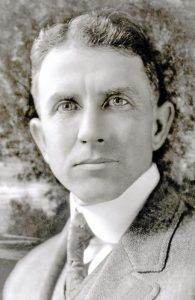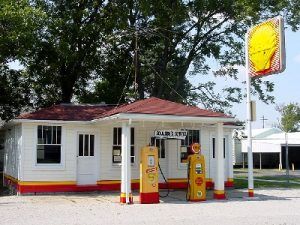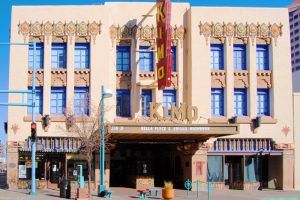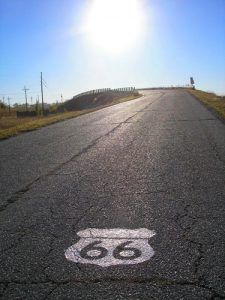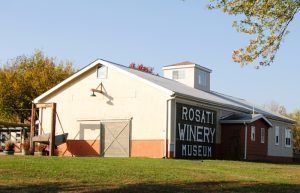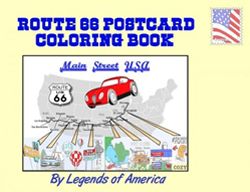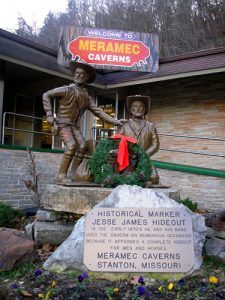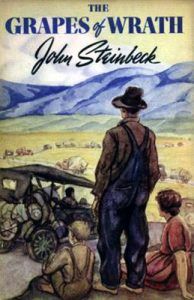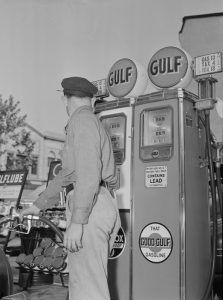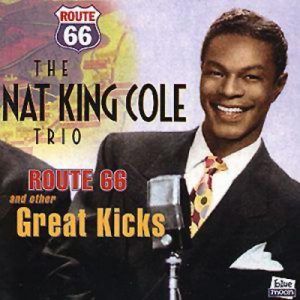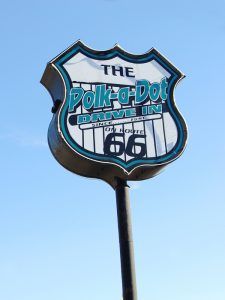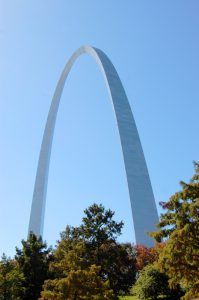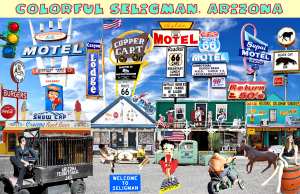Early 1920
Cyrus Avery, the highway commissioner of Tulsa, Oklahoma, leads an effort to link Chicago, Illinois, and Los Angeles, California, through his hometown of Tulsa.
1925
Cyrus Avery spends most of the year working with an appointed committee to stitch hundreds of existing roads into the new system.
1926
November 11, 1926 – Route 66 was officially commissioned for the Chicago-to-Los Angeles to include 2,448 miles of road. With that designation came its acknowledgment as one of the nation’s principal east-west arteries. Only 800 miles of Route 66 were paved by the end of the year.
Soulsby’s Station opens in Mt. Olive, Illinois.
The Old Log Cabin Restaurant opens for business in Pontiac, Illinois.
1927
The National Highway System was formed. People from eight states established a Route 66 Highway Association to expedite highway building. The theme name, “Main Street of America,” was adopted. Phillips 66 gasoline appropriates the magic numbers and logo as new gas stations sprout up along the highway.
Route 66 signs are posted in Illinois.
February 4, 1927 – The U.S. 66 Highway Association was formed in Tulsa, Oklahoma, and the road’s lifetime name, “The Main Street of America,” was born.
September 19, 1927 – The popular Kimo Theatre opens on Route 66 in Albuquerque, New Mexico.
1928
The Riviera Roadhouse was established in Gardner, Illinois.
Dixie’s Trucker’s Home was established in McLean, Illinois.
The last piece of Route 66 is finally completed through Missouri, between Rolla and Lebanon, the most challenging piece in the Show-Me State.
March 4, 1928 – The “First Annual International -Trans-Continental Foot Race,” or the “Bunion Derby” as it came to be known, starts in Los Angeles. The race covered the entire length of Route 66 to Chicago and then went on to Madison Square Garden in New York. Andy Payne wins the race and the first prize of $25,000, a 20-year-old from Claremore, Oklahoma – a Route 66 town and the stomping ground of Will Rogers. He covers 3,422.3 miles in 84 days, with an actual running time of 573 hours, 4 minutes, and 34 seconds.
1929
By this time, Illinois boasted approximately 7,500 miles of paved roads, including its portion of U.S. Highway 66. A Texaco road report published that same year noted the route was fully concreted in Kansas, 66% paved in Missouri, and 25% improved in Oklahoma. In contrast, the 1,200-mile western stretch (except for California’s metropolitan areas) never saw a cement mixer. Until the height of the Great Depression, Texas, New Mexico, Arizona, and the desert communities of southeast California collectively totaled only 64.1 miles of surfaced highway along Route 66.
Chicago is becoming dangerous, especially in the suburb of Cicero, which Route 66 runs through, and Al Capone makes his headquarters.
Ted Drewes Frozen Custard was established in St. Louis, Missouri.
The Old Mill Restaurant opened for business in Lincoln, Illinois, first called the Blue Mill.
The Ariston Café opens for business at its new location on Route 66 in Litchfield, Illinois.
July 29, 1929 – Taking 2 ½ years to build at the cost of some $2.5 million, the Chain of Rocks Bridge in St. Louis, Missouri, opens to traffic. It closed in 1968.
1930
By the 1930s, over 250,000 vines produced grapes along Route 66 near Rosati, Missouri.
1931
January 5, 1931 – Missouri was the third state to pave its portion of Route 66, following Illinois and Kansas. The last mile of the original Route 66 is paved in Phelps County, just east of the Pulaski County line near Arlington. The work crew tosses coins into the wet cement to celebrate the completion.
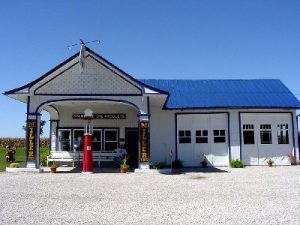
This 1932 Standard Oil Station now serves as a Route 66 Visitor’s Center in Odell, Illinois, by Kathy Alexander.
1932
Odell Standard Oil Station was established in Odell, Illinois. It closed in 1975 but remains a museum today.
Carr Phillips 66 Service Station was established in Cuba, Missouri.
1933
The Totem Pole Trading Post was established in Rolla, Missouri.
Until 1933, the responsibility to improve existing highways fell almost exclusively to the individual states. The more assertive and financially prepared states met the challenge. Initial improvements cost state agencies an estimated $22,000 per mile.
The U.S. Government puts thousands of unemployed male youths from virtually every state to work as laborers on road gangs to pave the final stretches of Route 66.
1934
The Wagon Wheel Motel was established in Cuba, Missouri.
In February 1934, the first Steak n Shake Drive-In was established in Normal, Illinois.
1935
Meramec Caverns opened for tourists near Stanton, Missouri. Soon, barns and billboards dot the west, and Route 66 entices visitors.
The Route 66 Cafe, first called the Belvidere Cafe, was established in Litchfield, Illinois.
June 17, 1935 – Route 66 is extended from downtown Los Angeles to its famous termination point overlooking the Pacific Ocean in Santa Monica, California.
June 17, 1935 – On the same date, 66 was rerouted over the Chain of Rocks Bridge in north St. Louis, Missouri.
1937
The Mar Theatre opens in Wilmington, Illinois.
The Pig Hip Restaurant was established in Broadwell, Illinois. It closed in 1992 and was then opened as a museum until it was destroyed by fire in March 2007.
The Normal Theater opened in Normal, Illinois.
September 26, 1937—Route 66’s route changed over the years, particularly in New Mexico, where its original winding of 506 miles was shortened to 399 miles. It was officially rerouted directly west from Santa Rosa to Albuquerque, New Mexico, bypassing Santa Fe on this date.
1938
By mid-year, paving is completed on the last unpaved section of Route 66 from Chicago to Santa Monica in Oldham County, Texas, between Adrian and Glenrio.
1939
John Steinbeck published The Grapes of Wrath and dubbed Route 66 “the Mother Road, the road of flight.”
1940
Steinbeck’s classic novel The Grapes of Wrath was made into a film that immortalized Route 66 in the American consciousness.
An old coffee and donut shop for railroad crews became the Eat-Rite Diner in St. Louis, Missouri.
1941
The famous Coral Court Motel opens in Marlborough, Missouri, a suburb of St. Louis. It closed in 1993 and, sadly, was demolished in 1995.
December 8, 1941 – The United States entered World War II.
1942
As a result of the war, automobile production ceased, gasoline rationing began, and tires became scarce, affecting Route 66. The massive creation of war industry jobs, mainly in California, brought another wave of migrating people across Route 66. The highway was necessary for military traffic, transporting troops, supplies, and equipment. The road was inadequate for its traffic, and the difficulty of maintaining it grew throughout the war.
1945
World War II ended, and Americans began traveling for leisure, a pastime primarily unknown to them.
The Gardenway Motel was established in Villa Ridge, Missouri.
1946
Jack D. Rittenhouse self-published A Guide Book to Highway 66 and sold it door-to-door at truck stops, motor courts, and cafes along the route. The book lists every community on the highway from Chicago to Los Angeles, along with attractions, lodgings, and services.
Robert (Bobby) William Troup, Jr., of Harrisburg, Pennsylvania, and former pianist with the Tommy Dorsey band and ex-Marine captain, penned a lyrical road map of the now-famous cross-country road in which the words, “Get your kicks on Route 66” became a catchphrase for countless motorists who moved back and forth between Chicago and the Pacific Coast. The famous recording was released in 1946 by Nat King Cole one week after Troup arrived in Los Angeles.
Ell Rhea’s Chicken Basket was first established as Kolarik’s Nationally Famous Chicken Basket in Willowbrook, Illinois. The name was changed in 1962.
1950
The “Family Vacation” begins as a new American phenomenon in the 1950s. Route 66 became a destination unto itself. With its caverns and caves, scenic mountains, beautiful canyons, and sparkling deserts heavily promoted by the U.S. 66 Highway Association, Route 66 became the ultimate road trip. This spawned trading posts, alligator farms, full-service gas stations, grills with fried chicken, “blue plate specials” and homemade pie, “mom and pop” motor courts, Native American festivals, and every other type of tourist trap.
The Tropics Restaurant opens in Lincoln, Illinois.
The Cozy Dog Drive-In was established in Springfield, Illinois.
Henry’s Drive-In was established in Cicero, Illinois.
1951
Spring, 1951 – The Skyview Drive-In opens in Litchfield, Illinois.
1953
Oklahoma was the first state to deal the route an official death blow. In 1953, the Turner Turnpike (I-44) between Tulsa and Oklahoma City opened, bypassing 100 miles of the legendary Mother Road. Other states followed suit while the federal government’s new four-lane, straight-as-an-arrow interstate system gobbled up section after section.
1955
The family-owned Circle Inn Malt Shop was established in Bourbon, Missouri.
1956
The Polk-A-Dot Drive-In was established in Braidwood, Illinois.
1957
President Eisenhower instituted the National Interstate Highway System (motivated by the German Autobahn system he had observed during the war.) Initially, the Interstate System was to be completed by 1972 but was not realized until 1982.
Zeno’s Motel and Steak House opens in Rolla, Missouri.
The Totem Pole Trading Post was established in Rolla, Missouri.
1960
The LaunchPad Drive-In opens in Wilmington, Illinois. The drive-in is the home to the Gemini Giant Statue, which was added in 1965.
The Route 66 TV series, starring Martin Milner and George Maharis, began on October 7, 1960. The show aired 116 episodes and ended on September 18, 1964.
1962
December 1962 – Missouri petitioned the American Association of State Highway and Transportation Officials, on behalf of all the Route 66 states, to have the interstates renumbered as I-66 from Chicago to Los Angeles. The request was refused.
1965
The Gateway Arch was built in downtown St. Louis, Missouri.
1970
By 1970, nearly all segments of the original Route 66 were bypassed by a modern four-lane highway.
1977
January 17, 1977 – All signs came down along Route 66 in Illinois, replaced by the super-highway Interstate 55.
1979
Route 66 Motors and Nostalgia Gift Shop are established in Rolla, Missouri.
1982
December 23, 1982 – The city of Times Beach, Missouri, is found to be severely contaminated by dioxin
1983
February 23, 1983 – The entire townsite of Times Beach, Missouri, was bought out by the Environmental Protection Agency. Two years later, every member of the former town was evacuated, and Times Beach was closed to visitors.
1984
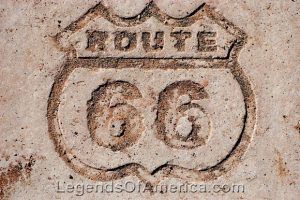
A Route 66 shield is carved in rock to commemorate where the Mother Road once ran through the Petrified Forest National Park in Arizona. Photo by Dave Alexander.
October 13, 1984 – The outdated, poorly maintained vestiges of U.S. Highway 66 wholly succumbed to the interstate system when the final section of the original road was bypassed by Interstate 40 at Williams, Arizona. The route was “replaced” by Interstates 55, 44, 40, 15, and 10.
1985
Route 66 was officially decommissioned, and the familiar highway markers came down.
1987
A small group from the Arizona Route 66 communities formed the Historic Route 66 Association of Arizona, led by Angel Delgadillo of Seligman and Jerry Richard and David Wesson, both of Kingman.
1995
New Historic Route 66 signs have been put up, documenting the different historic alignments in Illinois.
1999
In response to the recognized need to preserve the rich resources of the historic highway, Congress passed an act to create the Route 66 Corridor Preservation Program. Administered by the National Park Service, the program collaborates with private property owners, non-profit organizations, and local, state, federal, and tribal governments to identify, prioritize, and address Route 66 preservation needs.
The historic Chain of Rocks Bridge reopens to St. Louis, Missouri, pedestrian traffic.
September 11, 1999 – The new Route 66 State Park opens on the old townsite of Times Beach, Missouri.
2003
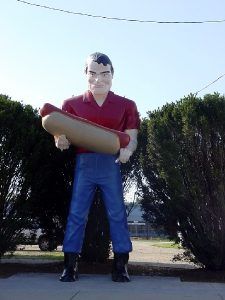
The Hot Dog Muffler Man stood for almost 40 years in Cicero, Illinois, before it found a new home in Atlanta by Kathy Alexander.
Cicero, Illinois’ famous 19-foot Bunyon Hot Dog, is moved to Atlanta, Illinois.
2004
The Illinois Route 66 Hall of Fame Museum was established in Pontiac, Illinois, in the restored Pontiac City Hall and Fire Station.
2018
The National Trust for Historic Preservation lists Route 66 among its 11 most at-risk sites, highlighting architectural and cultural spots it deems in danger of development or neglect.
©Kathy Alexander/Legends of America, updated January 2025.
Back to:
Route 66 Facts, Figures & Trivia


